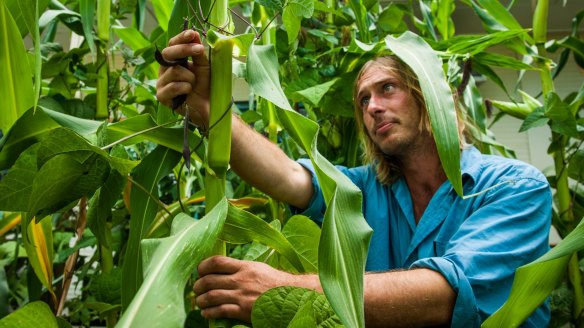Inside the gardens at the Canberra Environment Centre

At last month's passata-making and pizza day at the Canberra Environment Centre, the director of EcoAction, Ryan Lungu, was working the wood-fired pizza oven with skill.
The event had been listed online and hundreds of people responded via Facebook, so numbers had to be limited to 50.
At long tables outdoors, Australian National University students and others were chopping, sieving, cooking and bottling tomatoes for the passata, slicing pumpkin, zucchini and eggplant, and hand-pulling and rolling pizza dough.
Some were creating their own toppings for the pizzas, which Ryan placed on a long paddle and slid into the pizza oven – made from recycled Canberra red bricks by Maryke Henderson, of the Canberra Potters' Society. The smells and tastes were delicious.
Lungu was raised in Thirlmere, NSW, on a rural block with chickens, fruit trees and a big vegie garden. He graduated with a bachelor of commerce from the University of Sydney, but realised banking was not for him so he started a gardening business. He moved to Canberra four years ago to study for a masters degree in environmental management and development at the ANU.
Lungu started at the Canberra Environment Centre on a casual basis, delivering eco-therapy gardening workshops at Calvary Hospital, and has been director of the centre for two years. At home, he is growing scarlet runner beans, pumpkins, corn and potatoes, and is bottling his varieties of tomatoes.
Core funding for the centre comes from the ACT government's Environment and Planning Directorate and a Grow Together program funded by ACT Health.
Also at the event was environmental biologist and urban farmer Wieslaw Lichacz, with his two beautiful dogs. They didn't hassle the the two Isa Brown chickens in their henhouse beside the gathering. Wieslaw had brought ripe figs from his garden in Kambah, which were eaten fresh and used as a topping for dessert pizzas, with blue cheese.
In Kitchen Garden, June 2012, we featured ANU graduate Karina Bontes Forward, who was leading The Dirty Beanstalk team developing the ANU Co-op rooftop garden in Civic.
Bontes Forward has been working at the Environment Centre for six months, guiding work for the group which, three months ago, dug out all the weedy and persistent vinca behind a compost heap and planted butternut pumpkins and zucchini. The seedlings were raised in a greenhouse the group built on site and now the crops are thriving.
Bontes Forward led me on a garden tour past an established asparagus bed, Jalapeno chillies, capsicums, a potato bed, four tomato patches, which provided green zebra tomatoes for the passata, and cucumbers growing up pallets, held in place by twine.
There is a 10-year-old mulberry tree and a peach tree which, this season, produced kilos of yellow fruit that made very good peach ice-cream. A grapevine winds its wrist-thick stems around the building's front verandah and has produced a crop of seedless green grapes.
The site is among the historic Lennox House complex of buildings constructed from 1911-27, which became the Land & Survey Camp professional officers' mess. The Canberra Lawn Tennis Club was developed on the land in 1913.
The latest development at the Environment Centre is a greenhouse retro-fitted and installed with shelving. Bontes Forward showed me rows of pots of winter vegetable seedlings, including Brussels sprouts, Romanesco broccoli, purple broccoli, celeriac and purple kohlrabi, which have all been raised from Green Harvest and Eden Seeds. They were grown to sell at the recent Harvest Festival.
This year, the Milpa crop in front of the Canberra Environment Centre has been amazing. Milpa is a traditional Mexican technique, where the Mayan "three sisters" of maize, beans and squash are grown together, and these beds were developed in 2013 by Australian Polly Grace and Josue Gomez from Mexico.
The heirloom Balinese sweet corn is four metres high and stalks are wound round with purple climbing beans and underplanted with self-seeded potatoes and pumpkins, and a companion planting of Black Empress nasturtiums and sunflowers.
The secret to the splendid growth has been fertiliser made from dozens of comfrey plants growing around the building. Karina made 70 litres of comfrey tea and raised 40 comfrey plants for sale at the harvest festival.
Soon there will be another fine source of nutrients.
On Saturday, April 9, from 10am to noon, Wieslaw Lichacz is giving a hands-on workshop called "Introduction to Composting". He will share science experience and tricks to turn waste into organic matter.
Wieslaw explained to me that he has made his own compost culture, which is fungal rather than microbial, so it takes only two weeks to break down compostables.
Wieslaw plans to build a compost station with a clear front (from perspex or similar) so people can see the varying levels of composting activity. He collects food scraps and coffee grounds from the food co-op to add to his master compost at home and has recently helped the ANU housing co-op build a functioning compost system of their own.
The Canberra Environment Centre's Introduction to Composting workshop is on Saturday, April 9, at 10am. $20. Bookings on ecoaction.com.au.
Susan Parsons is a Canberra writer.